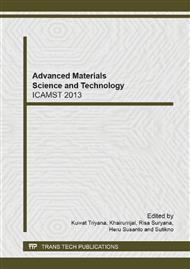p.596
p.600
p.605
p.609
p.613
p.617
p.621
p.626
p.633
Influence of Oxygen on Microstructures of Ti-Mo-Cr Alloy
Abstract:
In this study, the effect of oxygen addition on the microstructures of Ti-18%Mo-10%Cr alloy was investigated. The alloy was fabricated by a powder metallurgy method. The samples were subjected to sintering at 1300°C for 4 hours and furnace cooling. A Bo-Md method was initially applied for predicting stable phase. Calculation using the Bo-Md method showed that Ti-18%Mo-10%Cr alloy have bcc (β) phase at ambient temperature. All samples with various oxygen contents exhibited needle-like structures within equiaxed grains. The increase of oxygen content promoted formation of porosity in the α phase. Calculation of phase stability using JMatProTM showed that the decrease of β phase’s stability was not due to formation of the α phase on sintering, but due to promotion of nucleation and grain growth of diffusional α phase upon furnace cooling. It was also shown that vol.% of porosity of the alloy slightly increased with increasing oxygen content. Therefore, the increase of oxygen concentration could accelerate the formation of α phase and reduce the alloy’s density. The hardness increased as the oxygen concentration increased. The increase of the hardness might be due to combination of the solid solution hardening of oxygen and the precipitation hardening of α phase.
Info:
Periodical:
Pages:
613-616
Citation:
Online since:
February 2014
Keywords:
Price:
Сopyright:
© 2014 Trans Tech Publications Ltd. All Rights Reserved
Share:
Citation:


